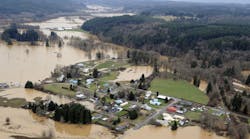AccuWeather meteorologists reported that impacts from Hurricane Ian will last well beyond the storm's point of impact in Florida.
Additionally, "Ian's projected path is expected to spread flooding rain and significant coastal concerns northward across the Southeast."
According to the latest Ian Eye Path from AccuWeather's, Hurricane Ian is making the second landfall in its life cycle just south of the Tampa Bay metro area late Sept. 28 or early Sept. 29.
AccuWeather reported that "a quick loss in wind intensity is projected as Ian slows down and encounters land after crashing ashore. Despite the fact that Ian will be downgraded on the Saffir-Simpson Hurricane Wind Scale, the storm’s impacts will worsen and expand in reach."
"No matter how quickly Ian loses wind intensity after moving inland, tropical rainfall is forecast to impact more than half a dozen states into Saturday," said AccuWeather Senior Meteorologist Courtney Travis, reported AccuWeather. "Another location that could experience higher rainfall totals compared to other parts of the Southeast is in the southern Appalachians. There, tropical moisture will be streaming up the mountains, which will cause enhanced rainfall."
A swath of rain from Georgia to Virginia is forecast to pick up at least 1-2 inches of rain from Hurricane Ian beginning Sept. 30 until the end of the weekend, reported AccuWeather. Moisture off the warm Gulf Stream waters of the Atlantic Ocean project higher rainfall totals of 4-8 inches for southeastern areas of Georgia and the Carolinas.
There are risks of flash flooding, rising streams and high water covering streets and high-terrain areas of the southern Appalachians, which are also at risk for mudslides, reported AccuWeather.
Cities including: Roanoke, Virginia; Raleigh and Charlotte, North Carolina; and Augusta, Georgia, are expected to receive several inches of rain, reported AccuWeather.
"Ian will slow down over the Southeast states, but as long as it maintains some forward speed, rainfall will be heavy but not over the top," AccuWeather Senior Meteorologist Alex Sosnowski said, reported AccuWeather. "However, if Ian stalls over the Southeast for a day or two, there is the potential for much heavier rainfall to fall over a broad area, including interior locations."
The storm's wind field is expected to expand, "resulting in tropical-storm-force wind gusts, which range from 39 to 73 mph, encompassing portions of Georgia and the Carolinas," reported AccuWeather.
AccuWeather reports that there is a risk of continued intense beach erosion due to the pounding waves.


